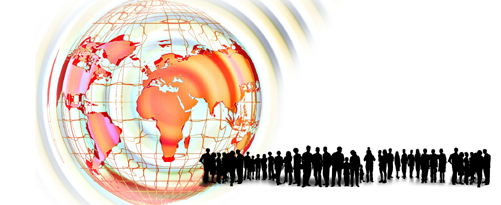A map of North America's physical, political, and population characteristics as of 2024
North America is a continent[b] in the Northern and Western Hemispheres.[c] North America is bordered to the north by the Arctic Ocean, to the east by the Atlantic Ocean, to the southeast by South America and the Caribbean Sea, and to the west and south by the Pacific Ocean. Greater North America includes the Bahamas, Bermuda, Canada, the Caribbean, Central America, Île Clipperton, Kalaallit Nunaat (Greenland), México, Saint-Pierre-et-Miquelon, the Turks and Caicos Islands, and the United States of America.
Continental North America covers an area of about 24,709,000 square kilometers (9,540,000 square miles), representing approximately 16.5% of the Earth's land area and 4.8% of its total surface area. It is the third-largest continent by size after Asia and Africa, and the fourth-largest continent by population after Asia, Africa, and Europe. As of 2013 , North America's population was estimated at nearly 579 million people in 23 independent states, or about 7.5% of the world's population. In human geography and in the English-speaking world outside the United States, particularly in Canada, the terms "North America" and "North American" are typically defined as including just Canada and the United States.[7][8][9][10][11]
It is unknown how and when first human populations reached North America. At present, people were known to live in the Americas at least 20,000 years ago[12] but various evidence points to possibly earlier dates.[13][14] The Paleo-Indian period in North America followed the Last Glacial Period, and lasted until about 10,000 years ago when the Archaic period began. The classic stage followed the Archaic period, and lasted from approximately the 6th to 13th centuries. Beginning in 1000 AD, the Norse were the first Europeans to begin exploring and ultimately colonizing areas of North America.
In 1492, the exploratory voyages of Christopher Columbus led to a transatlantic exchange, including migrations of European settlers during the Age of Discovery and the early modern period. Present-day cultural and ethnic patterns reflect interactions between European colonists, indigenous peoples, African slaves, immigrants from Europe, Asia, and descendants of these respective groups.
Some of those who suffered from shell shock were able to cope with it after the war, and even found that it lessened over time. But others � such as Bertram Steward's friend � were never able to readjust.
According to the American Psychological Association (APA), shell shock caused soldiers to have tremors, sensation deficits, headaches, confusion, nightmares, stammer, and extreme fatigue that together were symptomatic of 'repressed trauma' rather than any physical issue.



